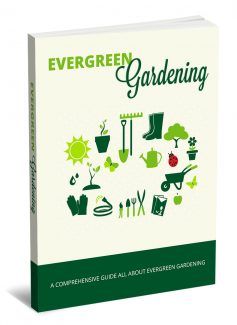 License Type: Master Resell Rights
License Type: Master Resell Rights  File Type: ZIP
File Type: ZIP
 SKU: 61468
SKU: 61468  Shipping: Online Download
Shipping: Online Download
Sample Content Preview
Introductory
Gardening is perhaps one of the best hobbies that a more laborious nature lover can take up.
The reason why I choose to call this hobby laborious is because it surely does involve a good deal of physical activity. This hobby is not meant for those nature lovers who simply want to bask in the natural beauty that already exists. Rather it is an ideal pass time for those who want to make their own contribution to the nature.
In order to be successful in gardening one must have the following qualities:
1.) Besides having a love for gardening you should also have the will and determination to pursue your hobby.
2.) You must be physically fit and agile. Laziness and gardening are anonymous to each other.
3.) Learn to exchange your ideas and information with like-minded people who can show an equal passion for gardening.
4.) Try laying your hands on almost any books, magazines or articles that can enhance your knowledge on gardening.
5.) Be prepared to invest a small amount of your earnings in purchasing the “Can’t do without”, gardening tools.
The world of gardening is wide and it has immense possibilities for those who want to explore it with the right zeal and enthusiasm. You can choose from indoor gardening, outdoor gardening, landscaping, cultivating exotic herbs, growing bonsais and thus the list is endless.
However, it is important to do a fair amount of research work before delving into any of the above fields. You should master up the art of choosing the right plants and also learn the techniques favorable for their productivity and growth.
Growing plants is not enough. Deciding where the plants should grow is also an important aspect of gardening. Nothing can be more distasteful than a garden which has color clashing flowers growing all around in a haphazardly manner. So be careful about allocating the plants their respective locations. Arrange the assortments of flowers in accordance with their heights, textures and colors so that they complement each other without diminishing the beauty of your garden.
Keep aside one day from the entire week to be your gardening day. Generally, week -ends would be a good choice. On this day, equip yourself with all the essential gardening tools and accessories and get down to your work. If you have children or friends who are equally interested in gardening call for their assistance. The more the merrier!
Once you are done for the day clean your tools well and store them in their right place. Be sure to maintain your gardening tools because well maintained tools can give you years of good performance. After all tools aren’t something that you can afford to buy every week.
Whether you are an efficient gardener or not can be best proved by your garden itself. So, stop twiddling your thumbs and put your green fingers to use. As far as gardening is concerned, if you have really put in hard work your efforts will never go futile.
Chapter 1: A Beautiful Garden Is A Work Of Heart
There is immense satisfaction in creating your own garden plan the satisfaction derived from relaxing or entertaining in the garden as well as the satisfaction that comes from a job well done.
The effort that you expend in planning and executing a design unique to you will add to the enjoyment your garden provides for years to come.
How do you begin to create a garden space that is unique to you? Here are ten simple steps that will help you move effortlessly through the process.
1. Identify WHY you want a garden.
How will you use it? Who else will enjoy the garden? Remember that you may not be the sole inhabitant, so get input from all family members on how your outdoor space will be used.
2. Do a little dreaming.
Now that you know why you want a garden and how you intend to use it, let your imagination play with all the possible features in your special space. A little dreaming will uncover those attributes that will put your personal imprint on the garden.
Also decide whether you want a formal or an informal garden. Formal gardens are highly structured, divided by a strong central axis and cross axes. Informal gardens have a more natural look with strong, flowing curves.
3. Make a list of "must haves".
What items are essential? Listing your needs up front ensures that your final plan won't be missing anything important. Do you need a retaining wall? A privacy fences? A path to the garage? More parking spaces? Do children need a place to play? What about pets?








